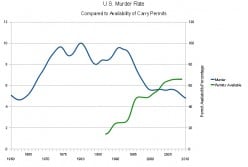Defensive Gun Incidents
This is one I haven't seen before. A study done by Florida State University professors of criminology Gary Kleck and Marc Gertz.
LINK: http://www.saf.org/LawReviews/KleckAndGertz1.htm
REVIEW: http://www.pulpless.com/gunclock/noframedex.html
The finding was that guns are used defensively to stop crimes up to 2.5 million times per year. 30% of these cases are listed as situations where a life was either 'certainly' saved, or 'probably' saved. Granted, that is a subjective percentage, but even 10% of those cases being cases where somebody would have died means that defensive gun usage saves 75,000 lives per year.
An interesting study for anyone interested in the topic of concealed/open carry statistics.Now, how many people were killed or permanently disabled by careless gun use?
613 accidental deaths and 15,000 injuries. About 5,000 of the injuries were serious enough to warrant hospitalization. The rest were treat/release.
Obviously gun safety is an important issue that should be focused on, but I think it's clear that there is benefit in allowing people to defend themselves in our country.
Compare that to 2,500,000 defensive uses of handguns, and a hyper-conservative(10%) life saving factor of 75,000 people.And how many killed or permanently disabled by deliberate gun use?
The matter at hand isn't whether or not guns should be banned. If we completely banned guns, the bad guys would still have them. We can't control what comes into our country.
The issue is whether or not allowing citizens to have guns/carry guns is a good thing or not. The data shows that it is a very good thing.
There are 12,000 murders with guns, and 45,000 injuries, on the 'intentional criminal' side of things.
FYI, only something like 7% of guns used in criminal activities are guns that were obtained legally.
When DC had the handgun ban and trigger lock act in place, the murder rate was 73% higher than before the ban and after it was repealed.OK, compare with the UK where we don't have universal gun ownership but have a death rate from shooting of 0.38 per 100 thousand compared with your death rate of 15.2 per 100 thousand!
That tends to blow all of your arguments right out of the water.John, I'm talking about guns in the US. I'm not talking about the UK.
Banning guns outright isn't an option for us. Even if we tried, the bad guys would still have them. The US is in a situation where guns are here whether we like them or not. The only question is, should citizens be able to purchase and carry them.
The answer is clearly yes. When states allow citizens to have guns, crime rates go down. When they ban guns, crime rates go up.
We would never be able to keep guns out of the hands of criminals in the US.We can't keep guns out of the hands of criminals either, but without the gun culture that you have criminals are less likely to carry them and less likely to use them.
+1 And without people thinking it is their God-given right to carry them.
No, we don't have the capability to get guns out of criminals hands, or even make it much less likely for them to have them. We have this thing called the US-Mexico border where tons of drugs and illegals come through. They can bring guns over too.
Every instance of banning guns in the US ends up with higher crime rates.
By the way, our homicide-by-gun rate is 4, not 15.
500 Children a year.
1.7 million children live in a home with an unlocked and loaded gun...
http://www.momlogic.com/2008/08/protect … m_guns.php
And crimes committed by legal guns statistics are misleading. Over 100,000 of the guns in the criminal hands each year were purchased legally, but stolen from their owners. This equates to approximately 1 million legal purchased hand guns currently in the hands of criminals. Essentially, the legal gun owners are arming the criminals. Those guns equal 10-15 percent of gun crimes per year.
27.7 percent of the guns used by criminals are sold by licensed dealers selling illegally. An addition 25 percent of guns used in crimes are stolen from gun dealers. Then there is the 8 percent that is purchased completely legally. Unless my math is off, that is 70-75 percent of guns being used in violent crimes that originate from a legitimate source.
http://www.usatoday.com/news/nation/200 … usat_x.htm
http://www.pbs.org/wgbh/pages/frontline … /guns.html
And some neat facts...
An estimated 41% of gun-related homicides and 94% of gun-related suicides would not occur under the same circumstances had no guns been present (Wiebe, p. 780).
Higher household gun ownership correlates with higher rates of homicides, suicides, and unintentional shootings (Harvard Injury Control Center).
Keeping a firearm in the home increases the risk of suicide by a factor of 3 to 5 and increases the risk of suicide with a firearm by a factor of 17 (Kellermann, 1992, p. 467; Wiebe, p. 771).
Keeping a firearm in the home increases the risk of homicide by a factor of 3 (Kellermann, 1993, p. 1084).
http://www.bradycampaign.org/facts/gunviolence
Do those stats help Paul?You'll have to forgive me for replying to your comment, but I don't want false information presented here.
122 accidental deaths in 2007 to children age 18 and under.
Source: CDC national center for injury prevention and control WISQARS system
Don't criticize me for using actual studies done by conservatives, when you quote baseless information from a blog.
First, that doesn't clarify 'children'. When I turned 15 my dad told me he was going to start keeping his 9mm loaded and showed me where it was. I was old enough to be responsible and handle that situation. I agree though, that young children shouldn't have access to loaded guns unsupervised. I am a huge proponent of gun safety.
Every responsible gun owner advocates safe storage of guns.
Your 27.7 stat is wrong. 120,000 guns were traced to FFLs. It didn't say they were originally purchased illegaly, just that they were purchased there. Of those 120,000, 27.7 percent were used in a crime within 2 years of being sold. Again, nothing to do with who bought it, just the timeline.
FYI, there are between 250-350 million guns in the US. Those 120,000 guns used in crimes account for only between 3 and 4 hundredths of one percent of guns.
Your 25% figure is wrong too. It's referring to a statistic used on a show. Your entire 70-75% 'math' is completely wrong.
The majority of gun-related homicides are committed by criminals with illegal guns. Us banning guns wouldn't change that situation.
The suicides don't change anything. Yes, if there wasn't a gun, the person wouldn't shoot themself. They would find another way to commit suicide. There are studies that show when guns are no longer availabe, the total suicide rate doesn't change. They suicides just shift from guns to other categories.
The article explains some of the flaws in the Kellerman studies. If you don't care to read it, that's your right, but it's good to look at both sides of any story to try and find the truth. Saying that having a gun increases risk of suicide by gun is not the same thing as saying having a gun increases risk of suicide. Those are two different ideas.
Again, Kellerman's studies are extremely flawed. First, he compares risk of homicide to gun ownership, while not accounting for the percentage of homicides that include guns. In other words, he includes cases where people are killed with knives as part of the statistic of increased homicide rates due to having a gun.
Secondly, his ratios are so small that his margin of error is relatively large. By Kellerman's standards, having a gun increases your chances of being killed, over the course of 40 years, by ~0.02% maximum. Margin of error with that statistic would be approximately +/- 0.015%.
Thirdly, Kellerman includes all 'gun in home' scenarios, including homes with drug usage, previous crime history, etc...
Statistically, he completely fails to isolate the variable of gun ownership. Of course more people with guns are going to die if you are counting criminals with illegal guns.
To put the 613 accidental deaths into perspective, there were the following number of accidental deaths in the following categories.
Cut/Stab - 111
Drowning - 3,400
Suffocation - 6,000
Poison - 20,000
Falling - 22,000Interesting...
"Since as many as 400,000 people a year use guns in situations where the defenders claim that they "almost certainly" saved a life by doing so, this result cannot be dismissed as trivial. If even one-tenth of these people are accurate in their stated perceptions, the number of lives saved by victim use of guns would still exceed the total number [Page 181] of lives taken with guns.
This is also too serious a matter to base conclusions on silly statistics comparing the number of lives taken with guns with the number of criminals killed by victims. [100] Killing a criminal is not a benefit to the victim, but rather a nightmare to be suffered for years afterward. Saving a life through DGU would be a benefit, but this almost never involves killing the criminal; probably fewer than 3,000 criminals are lawfully killed by gun- wielding victims each year, representing only about 1/1000 of the number of DGUs, and less than 1% of the number of purportedly life-saving DGUs. Therefore, the number of justifiable homicides cannot serve as even a rough index of life-saving gun uses. Since this comparison does not involve any measured benefit, it can shed no light on the benefits and costs of keeping guns in the home for protection."Right. They are saying, since we can't accurately measure the number of lives saved, or even the number of justified killings, those aren't the statistics that conclusions should be based off of. The footnotes in brackets are references to studies that did just that.
The paper in reference " Arthur L Kellermann & Donald T. Reay, Protection or Peril?, 314 NEW ENG. J. MED. 1557" states the following:
" For every case in which an individual used a firearm kept in the home in a self-defense homicide, there were 1.3 unintentional deaths, 4.6 criminal homicides, and 37 suicides involving firearms."
Kleck and Gertz are pointing out that this is a ridiculous statistic to base conclusions off of, since less than 1% of 'life saving DGU's' involve killing the criminal.I just thought I would put the odds of getting injured, or death by a firearm in some sort of a prospective here. All my data is from the CDC 2009 report on National Vital Statistics. http://www.cdc.gov/nchs/data/nvsr/nvsr59/nvsr59_04.pdf Injured by a firearm- 31,228. a rate of 10.2 Death by accidental poisoning & exposure to noxious subtances- 30,504 a rate of 9.9 Death by assult by a firearm (homicide) - 11,406 a rate of 3.7 Death by assult, all others (homicide)- 5,185 a rate of 1.7 Death by Emphysema - 10,916 a rate of 3.6 Death by cancer of the stomach- 11,139 a rate of 3.6 Accidental death by firearm- 588 a rate of 0.2 Death by tuberculosis- 547 a rate of 0.2 Suicide deaths by firearm- 18,689 a rate of 6.1 Suicide deaths by other - 17,859 a rate of 5.8 Total deaths by firearms - 30,683 a rate of 9.9 Deaths by motor accidents- 36,284 a rate of 11.8 Deaths by accidental falls- 24,834 a rate of 25.4 Drug induced deaths- 37,485 a rate of 12.2 Alchohal induced deaths- 24,263 a rate of 7.9 Deaths by alcohalic liver disease- 15,107 a rate of 4.9 Total deaths from alcohal - 39,360 a rate of 12.8 ( I don't know if this figure includes " drunk driving ' motor accidents'" or not) I hate to assume much of anything, but just as it stands to reason that a large amount of motor accidents are alcohal, and or drug (impaired) related, is it safe to assume the same can be said about violent crimes? I would think it would play some part in firearm injuries as well. We can't legislate stupidity.
This is one that truly troubles me, and should be considered, in my opinion, by anyone who depends on the police for their safety.
The D.C. Court of Appeals ruled in Warren v. District of Columbia(1981) that "a government and its agents are under no general duty to provide public services, such as police protection, to any particular citizen."
The Seventh Circuit Court of Appeals ruled in Bowers v. DeVito(1982) that “there is no constitutional right to be protected by the state against being murdered by criminals or madmen.”
The Supreme Court overturned a ruling in Castle Rock v. Gonzales(2005), exonerating police in failing to enforce a restraining order. A father had restrictions on when he was allowed to see his children. He abducted the children from their front yard. The mother called police, who visited her and told her to call back if they were still missing later. She called 3 more times and visited the police station, having a message from the father telling where the children were. About 3 hours after her visit to the police department, the father showed up at the police station, with the dead children in his car, and committed 'suicide by cop'.I had an idea of two statistics I wanted to compare. The U.S. average homicide rate per 100,000 citizens, and the percentage of U.S. citizens who lived in states with concealed carry permits.
From 1987 to 2009, there was a 370% increase in the number of citizens who had opportunity for concealed carry permits.
In the same time period there was a 44% decrease in the homicide rate.
When I chart state homicide rates vs. U.S. homicide rates, an interesting trend emerges. When Texas changed to shall-issue in 1995, it had averaged a homicide rate 43% above the national average for the 10 years prior. For the 10 years after the change, Texas averaged 8% higher than national average homicide rates.
When Florida changed to shall-issue in 1987, it had averaged 37% higher than the national average for the 10 years prior. For the 10 years after, it averaged 5% higher than the national average.
I'm currently compiling this kind of information on every state, but in my opinion, at least 50% of the U.S. National Average Homicide Rate decrease from ~1990-2000 is directly related to changing gun laws. When states with high murder-rates issue shall-carry gun laws, they decrease in homicide rate dramatically over the following decade.EDIT: I didn't realize the chart would be so small. The blue line is the homicide rate per 100,000 citizens for the U.S. The Green line shows the percentage of citizens that lived in concealed carry states for any given year.
Related Discussions
- 37
George Zimmerman arrested after threatened wife with a gun
by IslandBites 12 years ago
George Zimmerman was arrested after a domestic altercation. Allegedly, he threatened his wife and father-in-law with a gun. His wife filed divorce papers a few days ago.Is this going to prove (not legally of course) that he was indeed guilty of Trayvon's murder?Is this other example to why gun...
- 62
London UK. Violent crimes on the rise ?
by ahorseback 7 years ago
Machete , knives acid attacks ,cars , trucks ,bombs , gang beatings ..........seems to be an epidemic of crime rise in London lately , particularly those associated with the pro or anti-gun debate ? Kind of proves what the pro-gun people have been saying all along . ...
- 140
These Gun Safety Ideas WOULD Reduce Mass Killings
by Scott Belford 7 years ago
The following ideas would, I think, go a long way to REDUCE (not eliminate) mass killings in particular and death by gun overall.1. Heavily regulate ownership of any weapon classified as "semi-automatic", whether pistol or rifle. 2. Heavily regulate possession of any magazine over 10...
- 24
Is tracking down illegal gun owners more important to you than knowing where leg
by H C Palting 12 years ago
Is tracking down illegal gun owners more important to you than knowing where legal gun owners are?How would you feel if your name and address were published online because you own a gun? While many gun owners' info ends up on lists that can be viewed by the public, do you disagree with making this...
- 37
Gun Grab North America . In your opinion, are the anti gun groups going too far,
by Thomas Czech 11 years ago
Gun Grab North America .In your opinion, are the anti gun groups going too far, or not far enough?The governments of both, United States and Canada, along with the anti gun groups are pushing for tighter restrictions of firearms and an all out ban on certain guns. However, those who have firearms...
- 24
An Average of 86 Gun Deaths per Day
by SpanStar 12 years ago
For those who can turn a blind eye at 1000 death in or about a month will not be moved or swayed by NBCnews report pertaining to gun violence.NBCnews took a holiday weekend to look at gun violence and its report illustrated that there is about 86 deaths per day with regards to guns. Clearly with 86...











